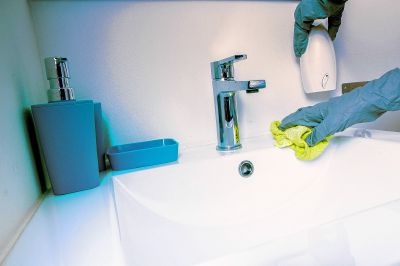As the days grow warmer, it’s time for Concord residents to start thinking about spring cleaning, a tradition experts recommend as a way to freshen up the home after the winter and clear the air for people who experience seasonal allergies.
For cleaning advice, we went straight to a local expert. Tammy Caveney, the owner and founder of Maid For You cleaning service company in Concord, says spring is the best season to do a refreshing deep-clean because the weather is nice, but not so nice that you’d rather be spending your time outside.
“A lot of people will start to open their windows in the spring. The days are longer, the sun is brighter, and you start to see all the buildup on your baseboards and on your ceiling fans,” Caveney explained. “Spring cleaning is super important to keep your home healthy, and to retain the value of the home as well.”
For those who may be wondering how to start, Caveney has some tips and tricks to share for a successful spring cleaning.
1. Work from left to right, top to bottom
Deep cleaning a whole home can feel like a daunting task, but Caveney says it’s easier when done in sections, focusing on one small area at a time. She recommends starting by the door of a room and cleaning a three-foot section, then moving a few steps to the right and focusing on a new section.
Professional cleaners always work from top to bottom, because dust and dirt fall from high areas like shelves and ceiling fans onto lower surfaces during the cleaning process.
“You go into a room and just immediately start cleaning that coffee table and then stand back and realize that you didn’t dust that ceiling fan that’s on top of that coffee table, now you have to start all over,” Caveney explained.
She recommends starting on the top floor of the house and dusting the high places in each room, then looping back once the dust settles to clean the lower surfaces and vacuum.
2. Have the right tools
Having the right tools can make all the difference in cleaning. Caveney recommends wearing an apron with big pockets that can hold the cleaning tools while moving from room to room. Some essential items to have on hand include an electrostatic duster, microfiber cleaning cloths, a toothbrush for scrubbing tiny spaces, and a garbage bag for collecting waste.
Caveney says microfiber cloths, which pick up dust better than cotton, are great because they can be laundered and reused. Professional cleaners use a technique of folding their cleaning cloths in half twice, giving them eight surfaces for cleaning — four on each side.
“If you have all the tools on you, you can make a really quick job of spring cleaning a room,” Caveney said.
3. Find the hidden areas
Caveney’s rule of thumb is that every surface in a home should get touched at least once a year, and an annual spring cleaning session is the perfect time to do it.
But some spots are easy to forget, including baseboards, the area around the base of the toilet, and spots hidden behind furniture which collect a lot of dust.
“Getting the baseboard by the headboard of the bed and moving out the furniture beside the bed like those side tables, that’s really important,” Caveney said. “So much dust gets back there because of the sheets scratching on each other and you spend seven or eight hours a day there, so that’s huge.”
4. Green keeps it clean
Although there are many cleaning products on store shelves to choose from, simple all-purpose cleaning solutions made with water, dish soap, or vinegar with essential oils for scent are just as effective, if not more so. Caveney warns DIY cleaners to steer clear of products with toxic ingredients that are known to contribute to asthma or cancer.
“The cleaning industry is a multi-billion dollar industry and they’re constantly spewing new products at you,” Caveney said. “I would suggest everybody go on the Environmental Working Group website and look for the cleaning product they’re about to buy and make sure it isn’t going to kill you. There’s a lot of cleaning products that are high toxicity, they’re really bad for the environment.”
Caveney said her employees clean mainly with water, and when they get to tougher areas like stoves they employ the “C.H.A.T.” technique – adding a chemical, heat, agitation, or time – to beat the grime.
Other products, like floor cleaners that claim to “shine” and “protect” the surfaces are unnecessary and unhelpful, according to Caveney, because they end up leaving their own residue behind on surfaces.
5. When to ask for help
Some places in a house are best left to professional cleaners, including chimneys, furnaces, and ductwork. Caveney says carpets and window sills should be on that list too. Carpets trap a lot of dust, dirt, and dead skin cells, Caveney said, and unless someone knows what they’re doing they could end up with dirty water in their carpet instead of removing debris. Windowsills, specifically the narrow strip between the window and the screen, collect grime from outdoors and Caveney says if the cleaning is done incorrectly it could result in debris dribbling down the outside of the house.
For renters and homeowners who do not want to tackle spring cleaning on their own, Caveney’s staff, who are trained via Association of Residential Cleaning Services International (ARCSI) courses, offer deep cleaning services to homes the greater Concord area. They also participate in a national program called Cleaning for a Reason, to offer free cleaning services to cancer patients going through chemotherapy.


 View Print Edition
View Print Edition